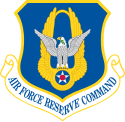U.S. Air Force Reserves
| Air Force Reserve Command | |
|---|---|

Headquarters, Air Force Reserve Command, Robins Air Force Base, Georgia
|
|
| Active | 1 August 1968 – 17 February 1997 (as: Air Force Reserve) 17 February 1997–present (as: Air Force Reserve Command) |
| Country |
|
| Branch |
|
| Type | Major Command |
| Role | Air Reserve Component (ARC) |
| Size | Nearly 70,000 personnel |
| Garrison/HQ | Robins Air Force Base, Georgia |
| Nickname(s) | AFRC |
| Commanders | |
| Current commander |
Lt Gen Maryanne Miller |
| Insignia | |
| Air Force Reserve Command Emblem |  |
| Aircraft flown | |
| Attack |
A-10 Thunderbolt II F-15E Strike Eagle MQ-1 Predator (UAS) |
| Bomber | B-52H Stratofortress |
| Electronic warfare |
E-3 Sentry |
| Fighter |
F-22 Raptor F-16 Fighting Falcon F-15E Strike Eagle |
| Multirole helicopter | HH-60G Pave Hawk |
| Reconnaissance |
U-28 RQ-4 Global Hawk (UAS) |
| Trainer |
T-1 Jayhawk T-6 Texan II T-38 Talon |
| Transport |
C-5 Galaxy C-17 Globemaster III C-40 Clipper HC-130P Combat King C-130 Hercules WC-130 Hurricane Hunter C-145 Skytruck |
| Tanker |
KC-10 Extender KC-135 Stratotanker |
The Air Force Reserve Command (AFRC) is a Major Command (MAJCOM) of the United States Air Force, with its headquarters at Robins Air Force Base, Georgia. It is the federally controlled Air Reserve Component (ARC) of the U.S. Air Force, consisting of duly appointed commissioned officers and enlisted airmen.
AFRC supports the Air Force mission to defend the United States through the control and exploitation of air and space by supporting Global Engagement. AFRC also plays an integral role in the day-to-day Air Force mission and is not strictly a force held in reserve for possible war or contingency operations.
The federal reserve component of the United States Air Force, AFRC has approximately 450 aircraft assigned for which it has sole control, as well as access to several hundred additional active duty USAF aircraft via AFRC "Associate" wings that are collocated with active duty Air Force wings, sharing access to those same active duty Air Force aircraft. The inventory, both AFRC-controlled and active duty Regular Air Force-controlled, includes the latest, most capable models of aircraft that are assigned to the U.S. Air Force. On any given day, 99 percent of AFRC's aircraft are mission-ready and able to deploy within 72 hours. In addition to flying units, AFRC has numerous ground organizations ranging from medical units to civil engineers, intelligence and space operations, and security forces, just to name a few.
The purpose of the Air Force Reserve, as derived from Title 10 of the United States Code (Title 10 U.S.C.), is to:
Provide combat-ready units and individuals for active duty whenever there are not enough trained units and people in the Regular component of the Air Force to perform any national security mission.
Unlike the Air National Guard, which alternates between a "state" status and a "federal" status via both Title 32 of the United States Code (Title 32 U.S.C.) and Title 10 U.S.C., the Air Force Reserve is strictly a "federal" reserve component under Title 10 U.S.C. and operates as an independent Major Command (MAJCOM), i.e., Air Force Reserve Command (AFRC). In combination with the Air National Guard, the Air Force Reserve comprises half of what is known as the Air Reserve Component (ARC) of the United States Air Force. AFRC forces are under the administrative control (ADCON) of the Commander, Air Force Reserve Command (AFRC/CC). When activated or mobilized (e.g., under 10 U.S.C. §§ 12301(a), 12302, 12304, 12304a, or 12304b), combatant command authority (COCOM) transfers to the combatant commander to which the forces are assigned/attached and operational control (OPCON) transfers to the operational chain of command established by that commander. In addition, AFRC forces are also assigned to deployable Air Expeditionary Forces (AEFs) and are subject to deployment tasking orders along with their active duty Regular Air Force and part-time Air National Guard counterparts in their assigned deployment cycle window.
...
Wikipedia
